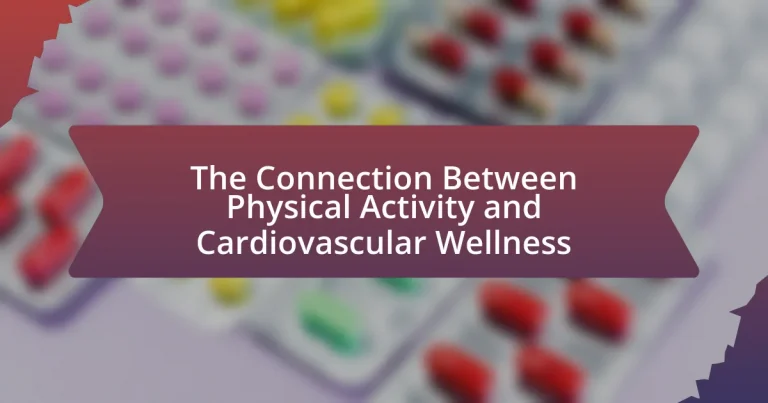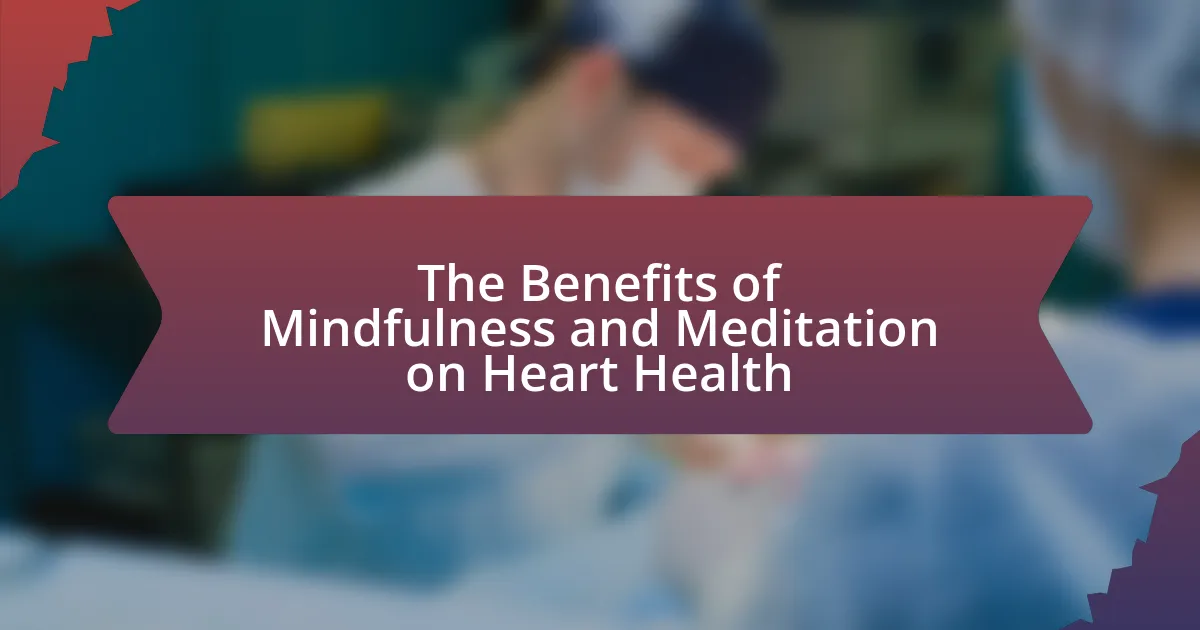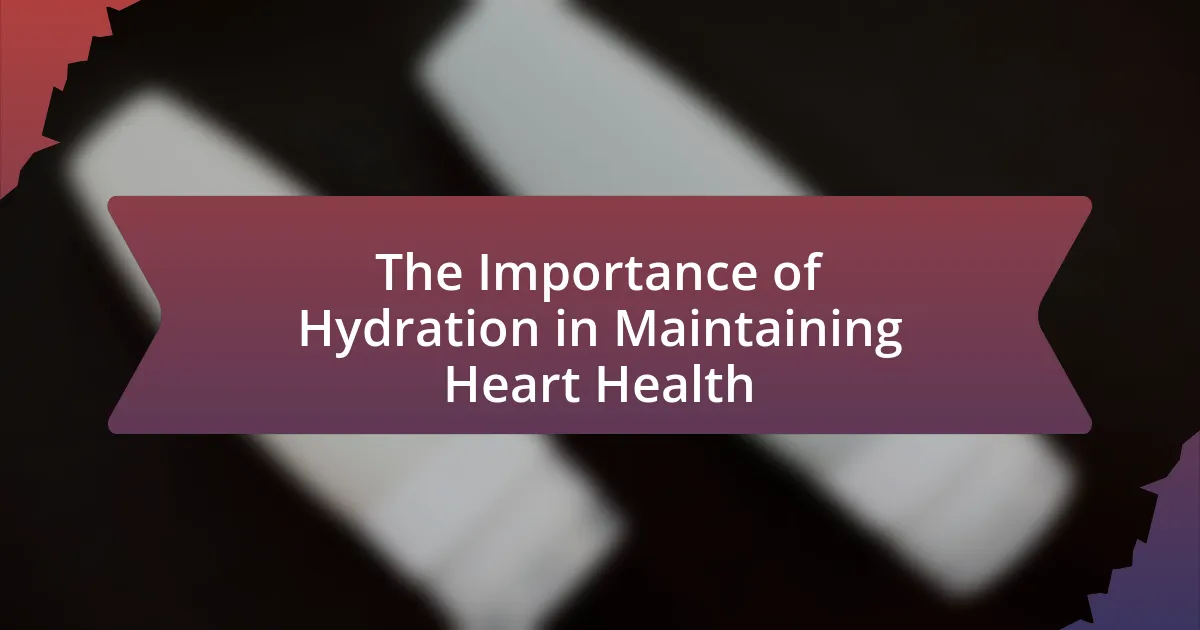The article examines the significant connection between physical activity and cardiovascular wellness, highlighting how regular exercise enhances heart health, reduces the risk of heart disease, and improves circulation. It details the physiological changes that occur in the cardiovascular system due to exercise, including improved heart function, lower blood pressure, and better cholesterol levels. The article also discusses the long-term effects of poor cardiovascular health, the psychological benefits of physical activity, and practical strategies for incorporating exercise into daily routines. Additionally, it addresses common misconceptions about exercise intensity and age-related barriers, emphasizing the importance of maintaining an active lifestyle for overall cardiovascular health.

What is the Connection Between Physical Activity and Cardiovascular Wellness?
Physical activity significantly enhances cardiovascular wellness by improving heart health, reducing the risk of heart disease, and promoting better circulation. Engaging in regular exercise strengthens the heart muscle, enabling it to pump blood more efficiently, which lowers blood pressure and improves cholesterol levels. According to the American Heart Association, individuals who engage in at least 150 minutes of moderate-intensity aerobic activity per week can reduce their risk of cardiovascular disease by up to 30-40%. This connection is further supported by studies indicating that physical activity helps manage weight, reduces inflammation, and improves insulin sensitivity, all of which are critical factors in maintaining cardiovascular health.
How does physical activity influence cardiovascular health?
Physical activity significantly improves cardiovascular health by enhancing heart function, reducing blood pressure, and improving lipid profiles. Regular exercise strengthens the heart muscle, allowing it to pump blood more efficiently, which can lower resting heart rate and improve overall cardiovascular endurance. Additionally, studies show that engaging in moderate-intensity aerobic exercise can lead to a reduction in systolic and diastolic blood pressure, contributing to lower risks of hypertension. Furthermore, physical activity positively influences cholesterol levels by increasing high-density lipoprotein (HDL) cholesterol while decreasing low-density lipoprotein (LDL) cholesterol and triglycerides, which are critical factors in cardiovascular disease risk. According to the American Heart Association, individuals who engage in at least 150 minutes of moderate aerobic activity weekly experience significant cardiovascular benefits, including a reduced risk of heart disease and stroke.
What physiological changes occur in the cardiovascular system due to exercise?
Exercise induces several physiological changes in the cardiovascular system, including increased heart rate, enhanced stroke volume, and improved cardiac output. During physical activity, the heart pumps more blood per beat, which increases the efficiency of oxygen delivery to muscles. Additionally, regular exercise leads to adaptations such as increased capillary density, improved endothelial function, and reduced resting heart rate. These changes contribute to better overall cardiovascular health, as evidenced by studies showing that individuals who engage in regular physical activity have a lower risk of heart disease and improved cardiovascular fitness levels.
How does regular physical activity affect heart rate and blood pressure?
Regular physical activity lowers resting heart rate and reduces blood pressure. Engaging in consistent exercise strengthens the heart muscle, allowing it to pump blood more efficiently, which leads to a lower heart rate over time. Additionally, physical activity promotes better blood vessel function and reduces arterial stiffness, contributing to lower blood pressure levels. Research indicates that individuals who engage in moderate-intensity aerobic exercise for at least 150 minutes per week can experience significant reductions in both systolic and diastolic blood pressure, as supported by findings from the American Heart Association.
Why is cardiovascular wellness important for overall health?
Cardiovascular wellness is crucial for overall health because it directly influences the efficiency of the heart and blood vessels, which are essential for delivering oxygen and nutrients throughout the body. A healthy cardiovascular system reduces the risk of heart disease, stroke, and other chronic conditions. According to the American Heart Association, regular physical activity strengthens the heart muscle, improves blood circulation, and helps maintain healthy blood pressure and cholesterol levels, all of which contribute to better cardiovascular health and, consequently, overall well-being.
What are the long-term effects of poor cardiovascular health?
Poor cardiovascular health can lead to several long-term effects, including an increased risk of heart disease, stroke, and other serious health complications. Specifically, individuals with poor cardiovascular health may experience chronic conditions such as hypertension, heart failure, and atherosclerosis, which can significantly impair quality of life. According to the American Heart Association, cardiovascular diseases are the leading cause of death globally, accounting for approximately 32% of all deaths in 2019. Additionally, poor cardiovascular health is associated with decreased physical fitness and increased fatigue, which can further limit physical activity and exacerbate health issues.
How does cardiovascular wellness impact quality of life?
Cardiovascular wellness significantly enhances quality of life by improving physical health, mental well-being, and overall functional capacity. Individuals with good cardiovascular health experience lower rates of chronic diseases, such as heart disease and diabetes, which directly correlates with increased longevity and reduced healthcare costs. Research indicates that regular physical activity, a key component of cardiovascular wellness, leads to improved mood and cognitive function, thereby enhancing mental health. For instance, a study published in the Journal of the American College of Cardiology found that individuals who engage in regular aerobic exercise have a 30-40% lower risk of depression. Furthermore, better cardiovascular health allows for greater physical endurance and mobility, enabling individuals to participate more fully in daily activities and social interactions, which are crucial for a fulfilling life.
What types of physical activities are most beneficial for cardiovascular health?
Aerobic exercises, such as running, cycling, swimming, and brisk walking, are the most beneficial physical activities for cardiovascular health. These activities increase heart rate and improve the efficiency of the cardiovascular system. Research indicates that engaging in at least 150 minutes of moderate-intensity aerobic exercise per week can significantly reduce the risk of heart disease and improve overall heart health. A study published in the Journal of the American College of Cardiology found that individuals who regularly participate in aerobic activities have a lower incidence of cardiovascular events compared to sedentary individuals.
Which aerobic exercises are recommended for improving heart health?
Aerobic exercises recommended for improving heart health include brisk walking, running, cycling, swimming, and dancing. These activities enhance cardiovascular fitness by increasing heart rate and promoting better blood circulation. Research indicates that engaging in at least 150 minutes of moderate-intensity aerobic exercise weekly can significantly lower the risk of heart disease and improve overall heart health. For instance, a study published in the Journal of the American College of Cardiology found that regular aerobic exercise reduces blood pressure and improves cholesterol levels, contributing to better cardiovascular outcomes.
How do strength training and flexibility exercises contribute to cardiovascular wellness?
Strength training and flexibility exercises contribute to cardiovascular wellness by enhancing overall physical fitness and promoting efficient blood circulation. Strength training increases muscle mass, which can improve metabolic rate and reduce body fat, leading to lower blood pressure and improved cholesterol levels. Flexibility exercises, such as stretching, enhance blood flow to muscles and joints, reducing the risk of injury and improving overall mobility. Research indicates that individuals who engage in regular strength training have a 20-30% lower risk of cardiovascular disease compared to those who do not, as noted in a study published in the Journal of the American Heart Association. This combination of strength and flexibility training supports heart health by fostering a more active lifestyle and reducing cardiovascular risk factors.
How can individuals incorporate physical activity into their daily routines?
Individuals can incorporate physical activity into their daily routines by integrating short bursts of exercise into everyday tasks. For example, taking the stairs instead of the elevator, walking or biking for short trips, and engaging in active hobbies like gardening or dancing can significantly increase daily physical activity levels. Research indicates that even small amounts of physical activity, such as 10 minutes of brisk walking, can improve cardiovascular health and reduce the risk of heart disease. The American Heart Association recommends at least 150 minutes of moderate-intensity aerobic activity per week, which can be achieved through consistent, manageable changes in daily habits.
What barriers do people face in maintaining physical activity for cardiovascular health?
People face several barriers in maintaining physical activity for cardiovascular health, including lack of time, motivation, and access to facilities. Research indicates that busy schedules often lead to prioritizing other responsibilities over exercise, with a study showing that 60% of adults cite time constraints as a significant barrier to regular physical activity. Additionally, low motivation can stem from perceived difficulty or lack of enjoyment in exercise, which can deter individuals from engaging in physical activity consistently. Access to facilities also plays a crucial role; individuals living in areas with limited recreational spaces or unsafe environments are less likely to participate in regular exercise, as highlighted by data indicating that neighborhoods with fewer parks and gyms correlate with lower physical activity levels.
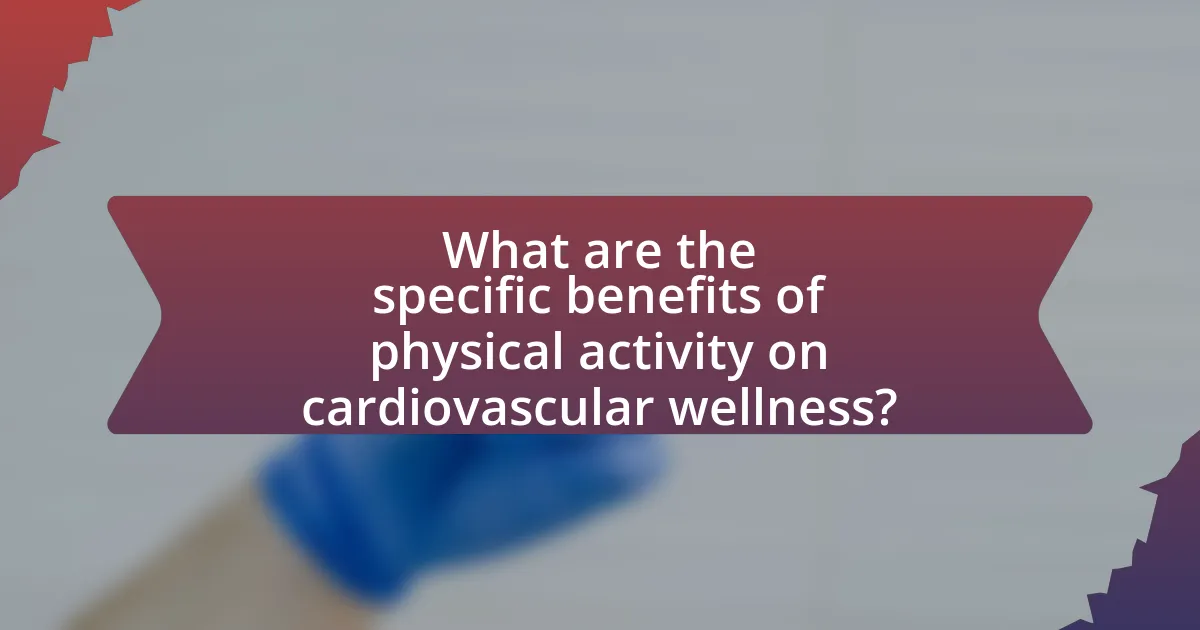
What are the specific benefits of physical activity on cardiovascular wellness?
Physical activity significantly enhances cardiovascular wellness by improving heart health, reducing blood pressure, and increasing overall cardiovascular efficiency. Regular exercise strengthens the heart muscle, enabling it to pump blood more effectively, which can lead to lower resting heart rates. Additionally, engaging in physical activity helps to lower blood pressure by improving the elasticity of blood vessels and promoting better circulation. According to the American Heart Association, individuals who engage in at least 150 minutes of moderate-intensity aerobic exercise weekly can reduce their risk of heart disease by 30-40%. Furthermore, physical activity aids in weight management, which is crucial for reducing the risk of cardiovascular diseases, as obesity is a major risk factor.
How does exercise reduce the risk of cardiovascular diseases?
Exercise reduces the risk of cardiovascular diseases by improving heart health, lowering blood pressure, and enhancing blood lipid profiles. Regular physical activity strengthens the heart muscle, enabling it to pump blood more efficiently, which reduces the workload on the heart. Additionally, exercise helps to lower levels of LDL cholesterol (often referred to as “bad” cholesterol”) while increasing HDL cholesterol (“good” cholesterol), contributing to better overall cardiovascular health. Studies indicate that individuals who engage in moderate to vigorous physical activity for at least 150 minutes per week have a significantly lower risk of developing heart disease, as evidenced by research published in the Journal of the American College of Cardiology, which found that regular exercise can reduce the risk of cardiovascular events by up to 30-40%.
What role does physical activity play in managing cholesterol levels?
Physical activity plays a crucial role in managing cholesterol levels by increasing high-density lipoprotein (HDL) cholesterol and lowering low-density lipoprotein (LDL) cholesterol. Regular exercise, such as aerobic activities, has been shown to improve lipid profiles; for instance, a study published in the Journal of the American College of Cardiology found that individuals who engaged in moderate to vigorous physical activity had significantly higher HDL levels and lower LDL levels compared to sedentary individuals. This effect is attributed to enhanced metabolism and improved insulin sensitivity, which collectively contribute to better cholesterol management.
How does regular exercise help in controlling weight and preventing obesity?
Regular exercise helps control weight and prevent obesity by increasing energy expenditure and improving metabolic health. Engaging in physical activity burns calories, which contributes to a caloric deficit necessary for weight loss. For instance, a study published in the Journal of Obesity found that individuals who participated in regular aerobic exercise lost more weight compared to those who did not engage in physical activity. Additionally, exercise enhances insulin sensitivity and regulates hormones related to appetite, further aiding in weight management. This combination of increased calorie burn and improved metabolic function underscores the critical role of regular exercise in combating obesity.
What psychological benefits does physical activity provide related to cardiovascular health?
Physical activity provides significant psychological benefits that enhance cardiovascular health, primarily by reducing stress and anxiety levels. Engaging in regular exercise leads to the release of endorphins, which are neurotransmitters that promote feelings of happiness and well-being. Research indicates that individuals who participate in physical activity experience lower rates of depression and anxiety, which can contribute to improved heart health. For instance, a study published in the Journal of Clinical Psychiatry found that regular exercise can reduce symptoms of anxiety by up to 20%. Additionally, physical activity fosters better sleep patterns and boosts self-esteem, both of which are crucial for maintaining a healthy cardiovascular system.
How does exercise impact stress and anxiety levels?
Exercise significantly reduces stress and anxiety levels by promoting the release of endorphins, which are natural mood lifters. Engaging in physical activity leads to physiological changes, such as decreased levels of the stress hormone cortisol and increased serotonin production, contributing to improved mood and relaxation. Research published in the Journal of Clinical Psychiatry indicates that regular aerobic exercise can reduce symptoms of anxiety and depression by up to 50%. Additionally, a meta-analysis in the journal Health Psychology Review found that exercise is associated with lower anxiety levels across various populations, reinforcing the positive impact of physical activity on mental health.
What is the relationship between physical activity and mental well-being?
Physical activity significantly enhances mental well-being by reducing symptoms of anxiety and depression while improving mood and cognitive function. Engaging in regular exercise releases endorphins, which are chemicals in the brain that act as natural painkillers and mood elevators. Research published in the Journal of Clinical Psychiatry indicates that individuals who participate in physical activity experience a 20-30% reduction in depressive symptoms. Additionally, a study by the American Psychological Association found that even moderate exercise can lead to improvements in mental health, demonstrating a clear link between physical activity and enhanced psychological resilience.
How does age affect the relationship between physical activity and cardiovascular wellness?
Age significantly influences the relationship between physical activity and cardiovascular wellness, with older adults often experiencing greater benefits from regular exercise. As individuals age, physiological changes such as decreased heart rate variability, increased arterial stiffness, and reduced muscle mass occur, which can negatively impact cardiovascular health. Engaging in regular physical activity helps mitigate these effects by improving heart function, enhancing circulation, and reducing the risk of cardiovascular diseases. Research indicates that older adults who participate in moderate-intensity aerobic exercise can lower their risk of heart disease by up to 30-40%, demonstrating the critical role of physical activity in promoting cardiovascular wellness across different age groups.
What considerations should older adults keep in mind regarding exercise?
Older adults should prioritize safety, medical clearance, and appropriate exercise intensity when engaging in physical activity. Safety is crucial to prevent injuries; thus, older adults should choose low-impact exercises that minimize stress on joints, such as walking, swimming, or cycling. Medical clearance from a healthcare provider is essential, especially for those with pre-existing conditions, as it ensures that the chosen exercise regimen is suitable and safe. Additionally, older adults should focus on moderate-intensity activities, as research indicates that such levels of exercise can significantly improve cardiovascular health without overexertion. According to the American Heart Association, regular physical activity can reduce the risk of heart disease, stroke, and other cardiovascular issues, making these considerations vital for maintaining overall wellness.
How can younger individuals establish healthy habits for lifelong cardiovascular wellness?
Younger individuals can establish healthy habits for lifelong cardiovascular wellness by engaging in regular physical activity, maintaining a balanced diet, and avoiding tobacco use. Regular physical activity, such as aerobic exercises, has been shown to improve heart health by reducing blood pressure and cholesterol levels, as evidenced by a study published in the Journal of the American College of Cardiology, which found that individuals who exercised regularly had a 30-40% lower risk of cardiovascular disease. Additionally, a balanced diet rich in fruits, vegetables, whole grains, and lean proteins supports cardiovascular health by providing essential nutrients and reducing the risk of obesity, which is a significant risk factor for heart disease. Avoiding tobacco use is crucial, as smoking is linked to a higher incidence of heart disease; the American Heart Association states that smokers are twice as likely to have a heart attack compared to non-smokers. By incorporating these practices, younger individuals can significantly enhance their cardiovascular wellness throughout their lives.
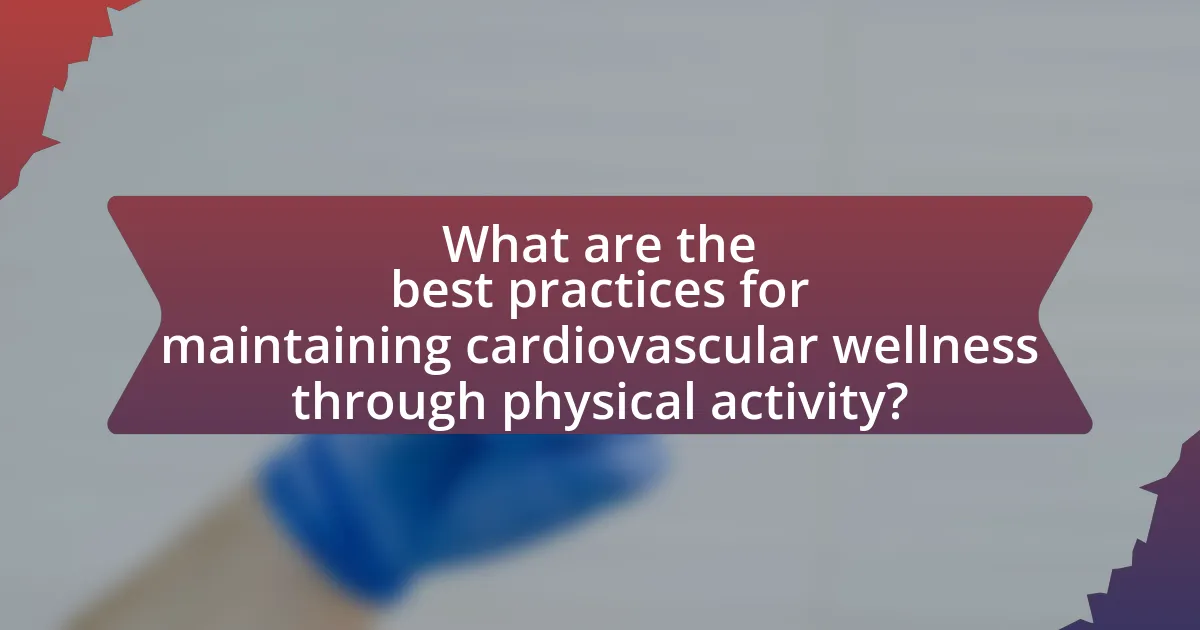
What are the best practices for maintaining cardiovascular wellness through physical activity?
Engaging in regular aerobic exercise is the best practice for maintaining cardiovascular wellness through physical activity. Activities such as brisk walking, running, cycling, and swimming enhance heart health by improving circulation, lowering blood pressure, and reducing cholesterol levels. The American Heart Association recommends at least 150 minutes of moderate-intensity or 75 minutes of vigorous-intensity aerobic activity each week to achieve these benefits. Additionally, incorporating strength training exercises at least twice a week can further support cardiovascular health by improving muscle mass and metabolic function. Studies show that individuals who adhere to these guidelines experience a significantly lower risk of heart disease and related conditions, reinforcing the importance of consistent physical activity for cardiovascular wellness.
How can individuals set realistic fitness goals for cardiovascular health?
Individuals can set realistic fitness goals for cardiovascular health by assessing their current fitness level, defining specific and measurable objectives, and gradually increasing intensity and duration. For instance, a beginner might aim to walk for 20 minutes three times a week, while someone more experienced could target 150 minutes of moderate aerobic activity weekly, as recommended by the American Heart Association. This approach ensures that goals are attainable and aligned with personal capabilities, reducing the risk of injury and promoting sustained engagement in physical activity.
What strategies can help in tracking progress and staying motivated?
To effectively track progress and stay motivated in physical activity, individuals should utilize specific strategies such as setting measurable goals, maintaining a workout journal, and leveraging technology. Setting measurable goals, such as aiming for a certain number of steps per day or a specific duration of exercise each week, provides clear benchmarks for progress. Maintaining a workout journal allows individuals to record their activities, monitor improvements, and reflect on their journey, which reinforces commitment. Additionally, using fitness apps or wearable devices can provide real-time data on performance metrics, making it easier to visualize progress and stay engaged. Research indicates that individuals who track their physical activity are more likely to adhere to their exercise routines, as evidenced by a study published in the Journal of Physical Activity and Health, which found that self-monitoring significantly enhances motivation and accountability in fitness pursuits.
How can one create a balanced exercise routine that promotes cardiovascular wellness?
To create a balanced exercise routine that promotes cardiovascular wellness, one should incorporate a mix of aerobic, strength training, and flexibility exercises. Aerobic activities, such as running, cycling, or swimming, should be performed for at least 150 minutes per week at moderate intensity, as recommended by the American Heart Association. Strength training exercises, targeting major muscle groups, should be included at least twice a week to enhance overall fitness and support cardiovascular health. Additionally, flexibility exercises, such as stretching or yoga, can improve range of motion and reduce injury risk. This combination not only enhances cardiovascular endurance but also contributes to overall physical health, as supported by numerous studies linking regular physical activity to reduced heart disease risk and improved heart function.
What common misconceptions exist about physical activity and cardiovascular health?
Common misconceptions about physical activity and cardiovascular health include the belief that only intense exercise is beneficial and that physical activity is only necessary for weight loss. Many individuals think that moderate activities, such as walking or gardening, do not contribute significantly to heart health, despite research indicating that even low to moderate physical activity can reduce the risk of cardiovascular disease. Additionally, some people assume that once they reach a certain fitness level, they no longer need to maintain regular activity, while studies show that consistent physical activity is crucial for ongoing cardiovascular health benefits.
How can misinformation about exercise intensity affect cardiovascular wellness?
Misinformation about exercise intensity can negatively impact cardiovascular wellness by leading individuals to engage in either insufficient or excessive physical activity. When people misunderstand the appropriate intensity levels required for effective cardiovascular training, they may not achieve the necessary heart rate zones that promote heart health. For instance, research indicates that moderate-intensity exercise, such as brisk walking, is essential for improving cardiovascular fitness, while high-intensity workouts can be beneficial but may pose risks if not approached correctly. A study published in the Journal of the American College of Cardiology found that individuals who adhered to recommended exercise intensities had a significantly lower risk of cardiovascular disease compared to those who did not. Thus, accurate information about exercise intensity is crucial for optimizing cardiovascular health outcomes.
What myths about age and exercise should be addressed?
Myths about age and exercise that should be addressed include the belief that older adults cannot benefit from physical activity and that exercise is inherently dangerous for them. Research indicates that regular exercise can improve cardiovascular health, strength, and flexibility in older adults, reducing the risk of heart disease and enhancing overall quality of life. A study published in the Journal of the American College of Cardiology found that older individuals who engage in moderate exercise experience significant cardiovascular benefits, including improved heart function and reduced mortality rates. Additionally, the misconception that older adults should avoid high-intensity workouts is misleading; many can safely participate in such activities with proper guidance, as evidenced by findings from the American Heart Association, which advocate for tailored exercise programs for seniors.
What are practical tips for integrating more physical activity into daily life?
To integrate more physical activity into daily life, individuals can incorporate simple changes such as taking the stairs instead of the elevator, walking or biking for short trips, and scheduling regular exercise sessions into their daily routines. Research indicates that even small amounts of physical activity can significantly improve cardiovascular health; for instance, the American Heart Association recommends at least 150 minutes of moderate aerobic activity per week to reduce the risk of heart disease. Additionally, standing or walking during phone calls and engaging in active hobbies like gardening or dancing can further enhance daily activity levels, contributing positively to overall cardiovascular wellness.
